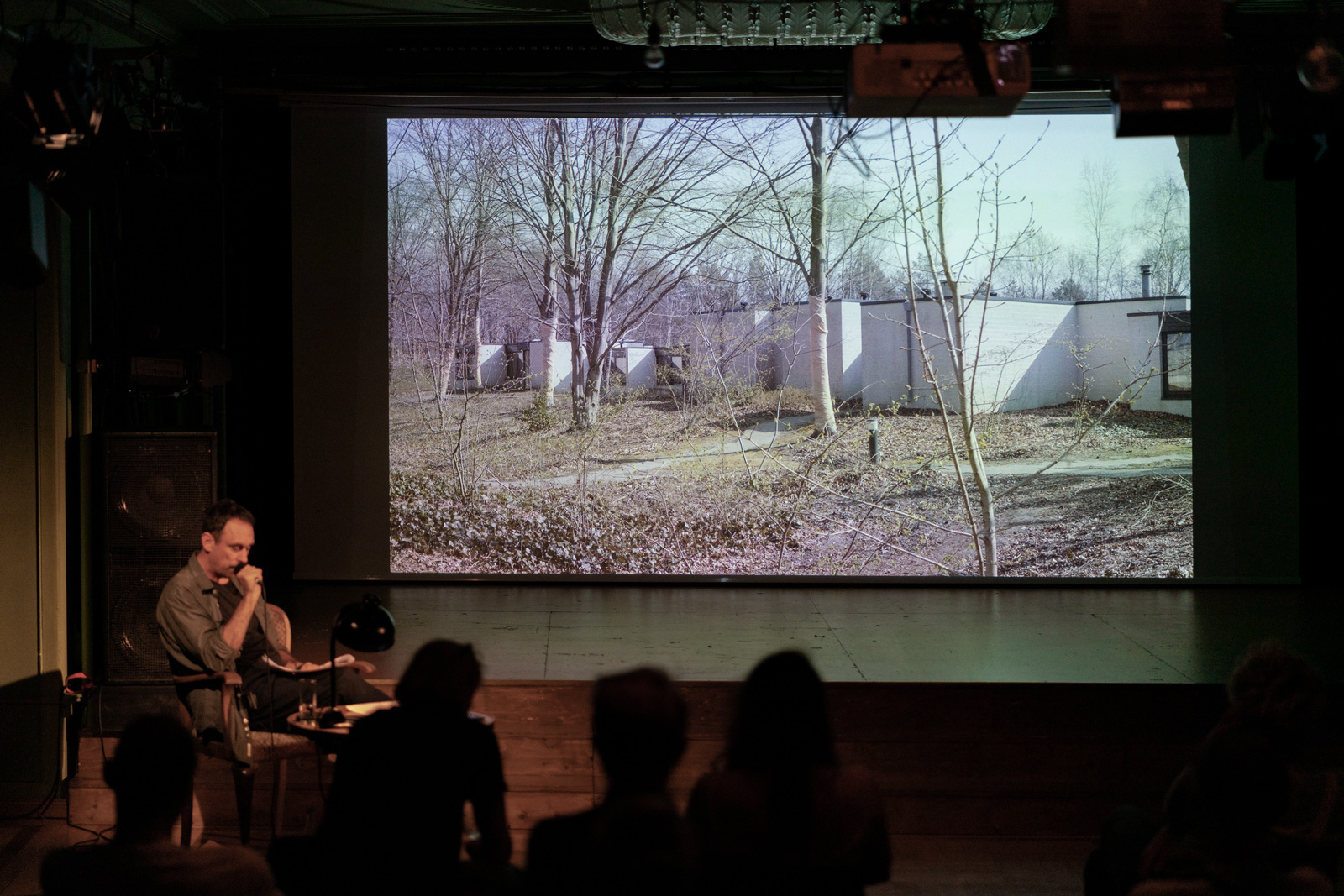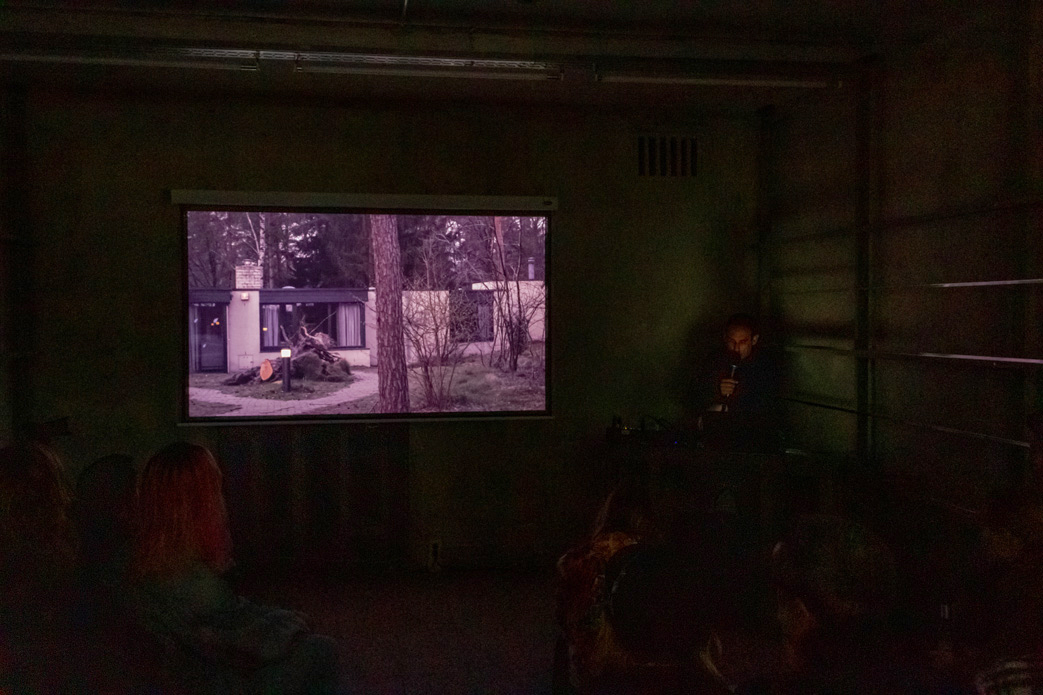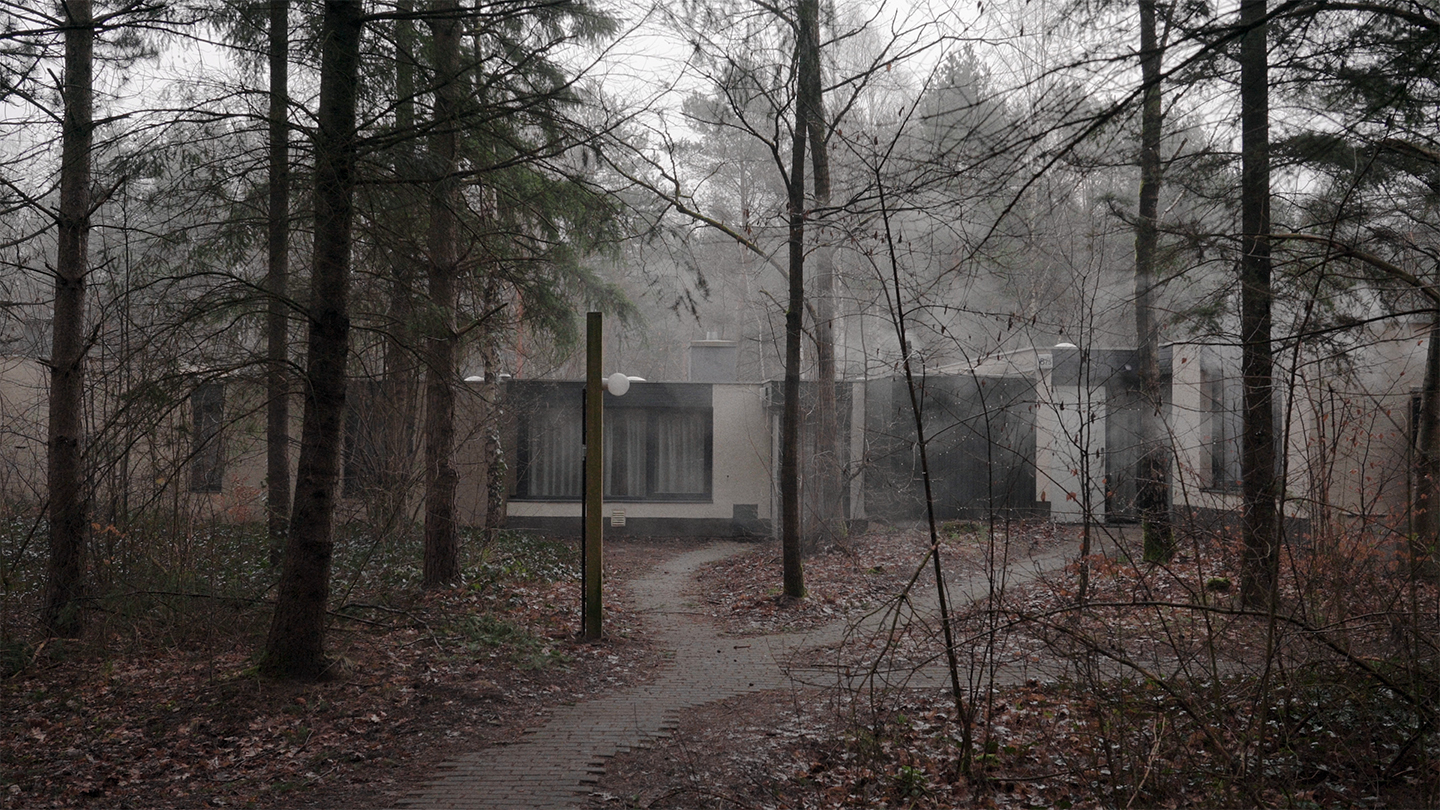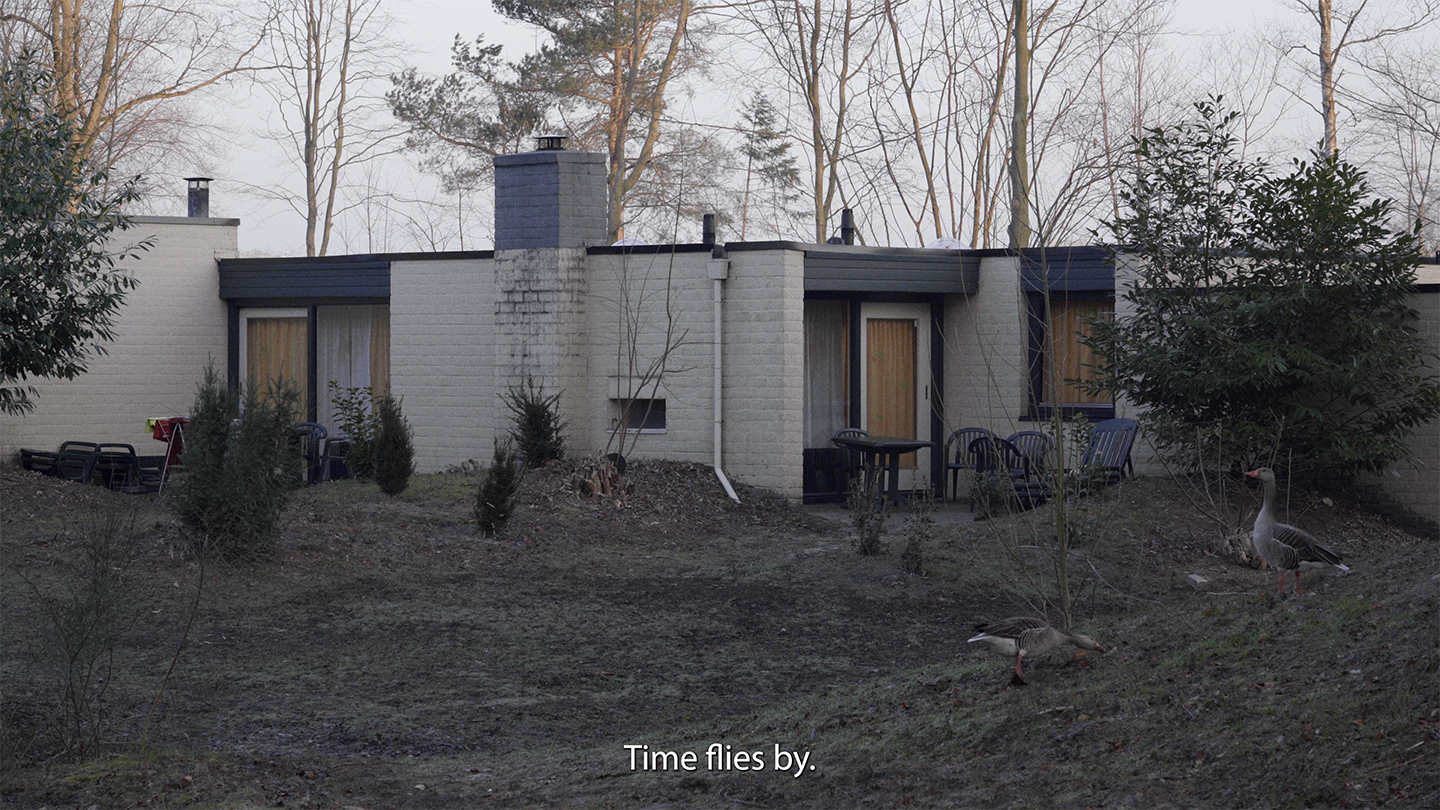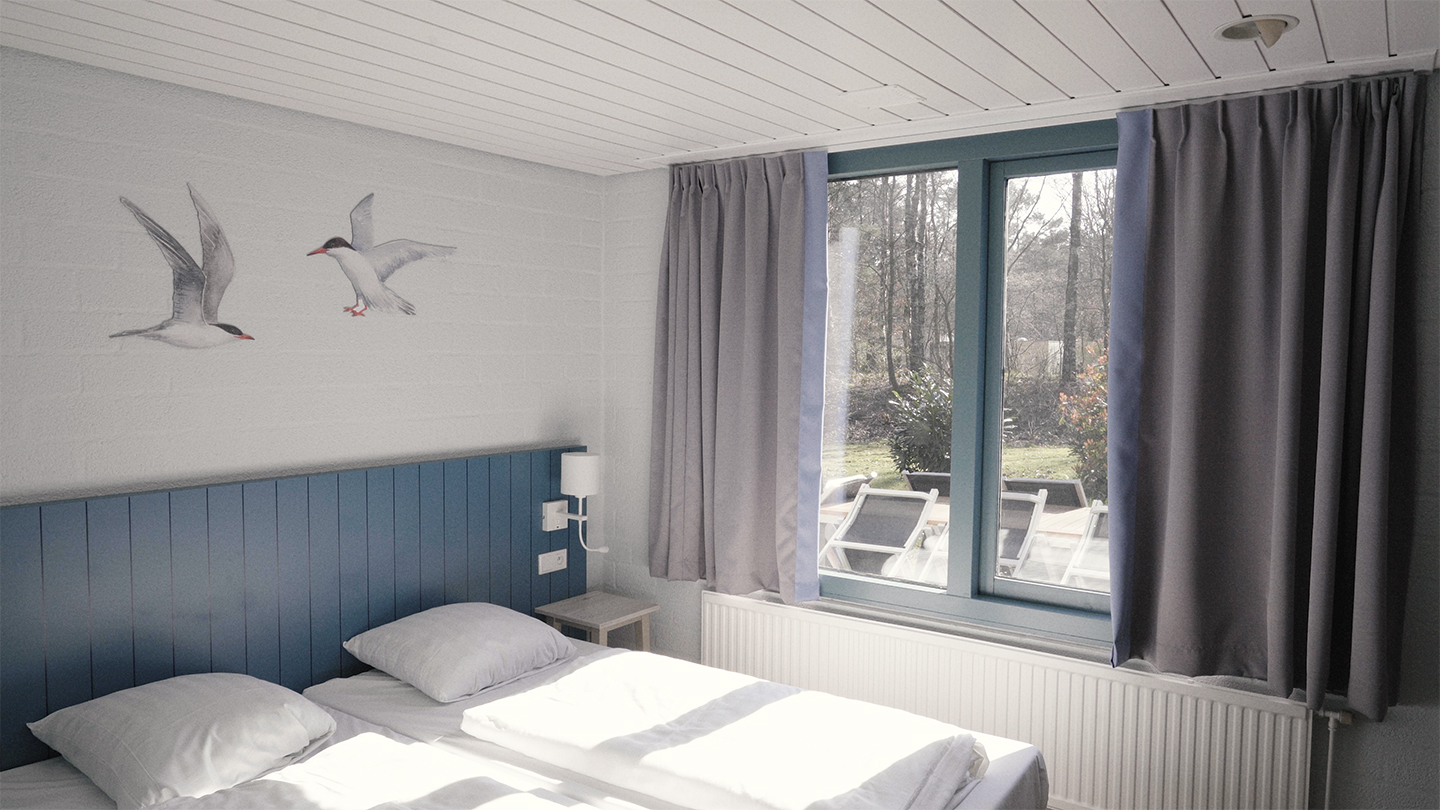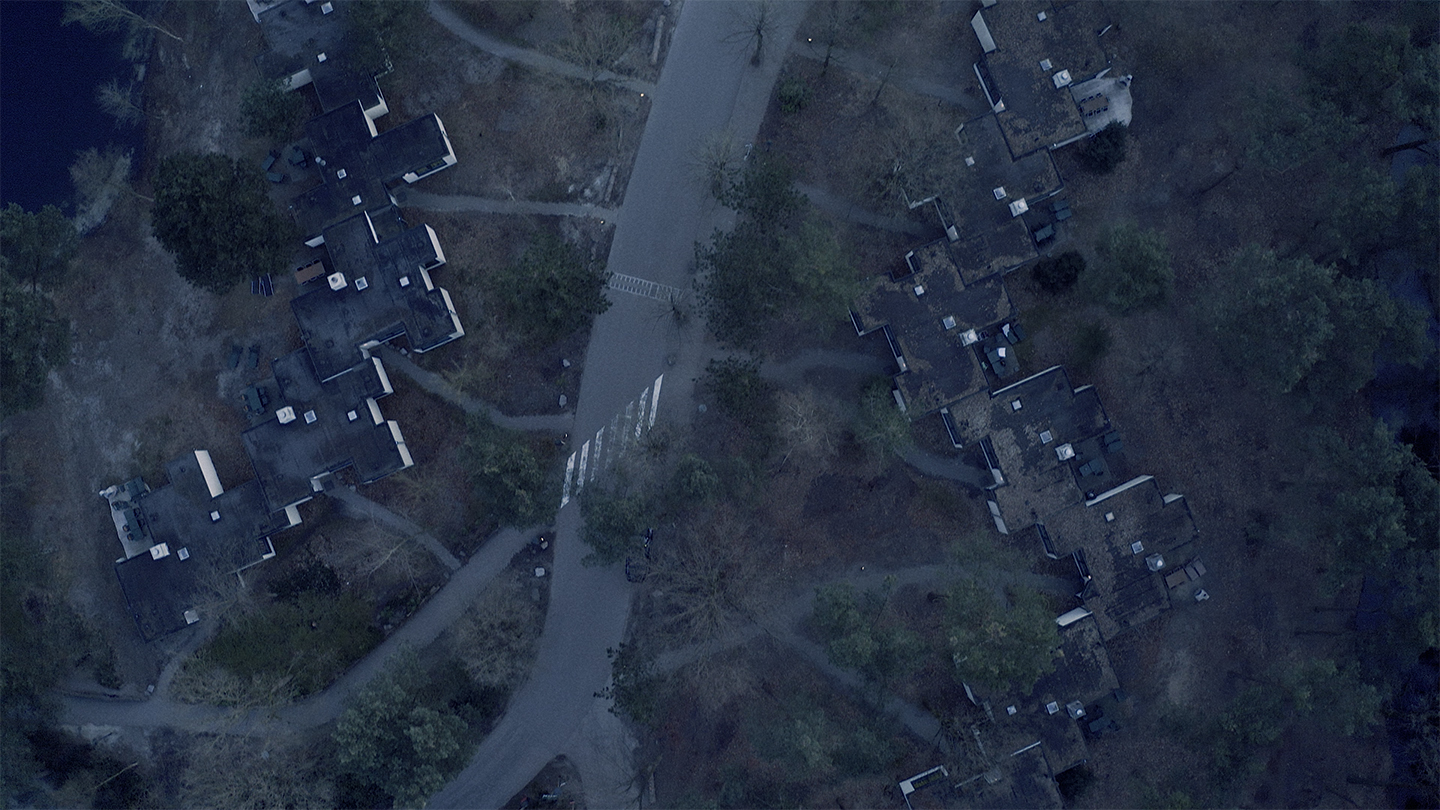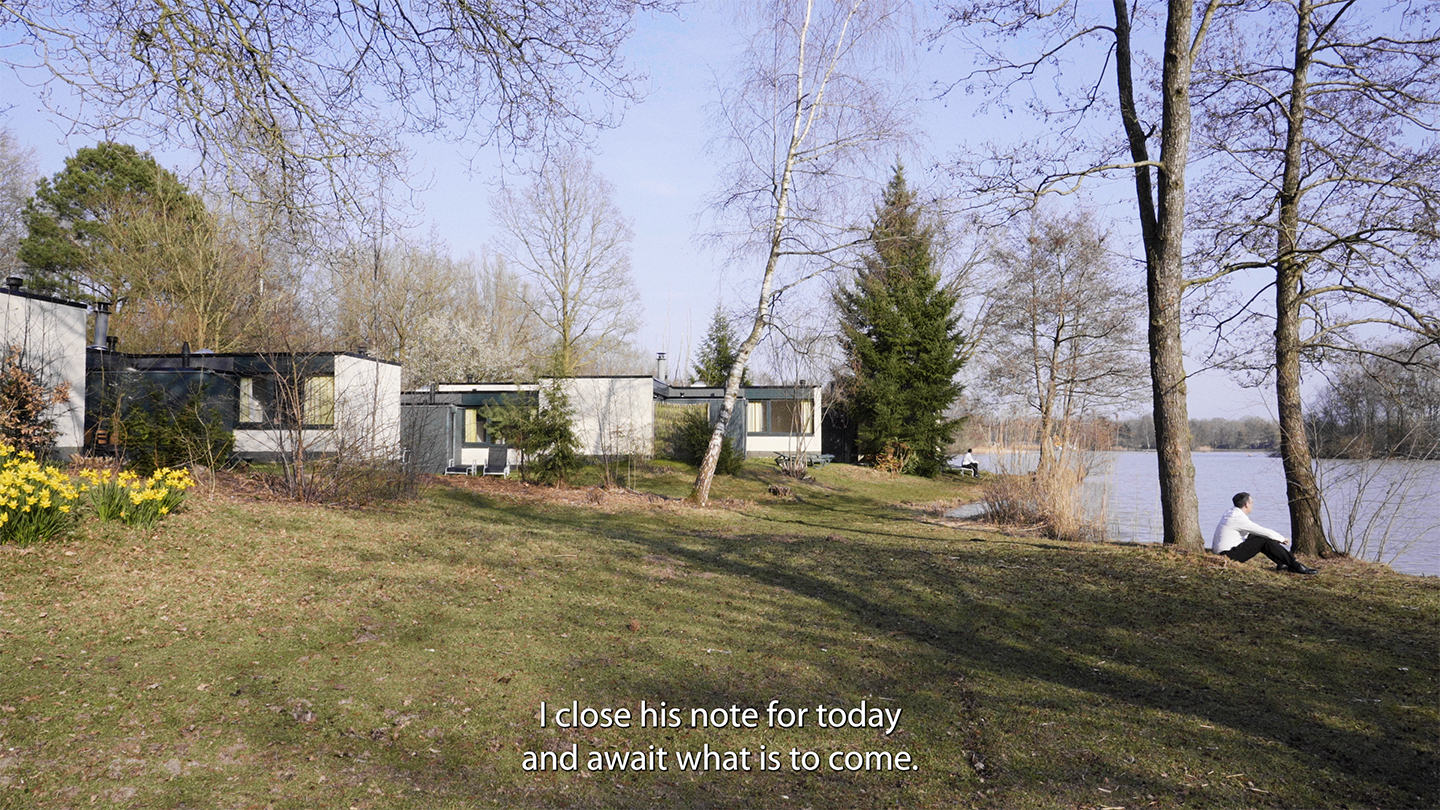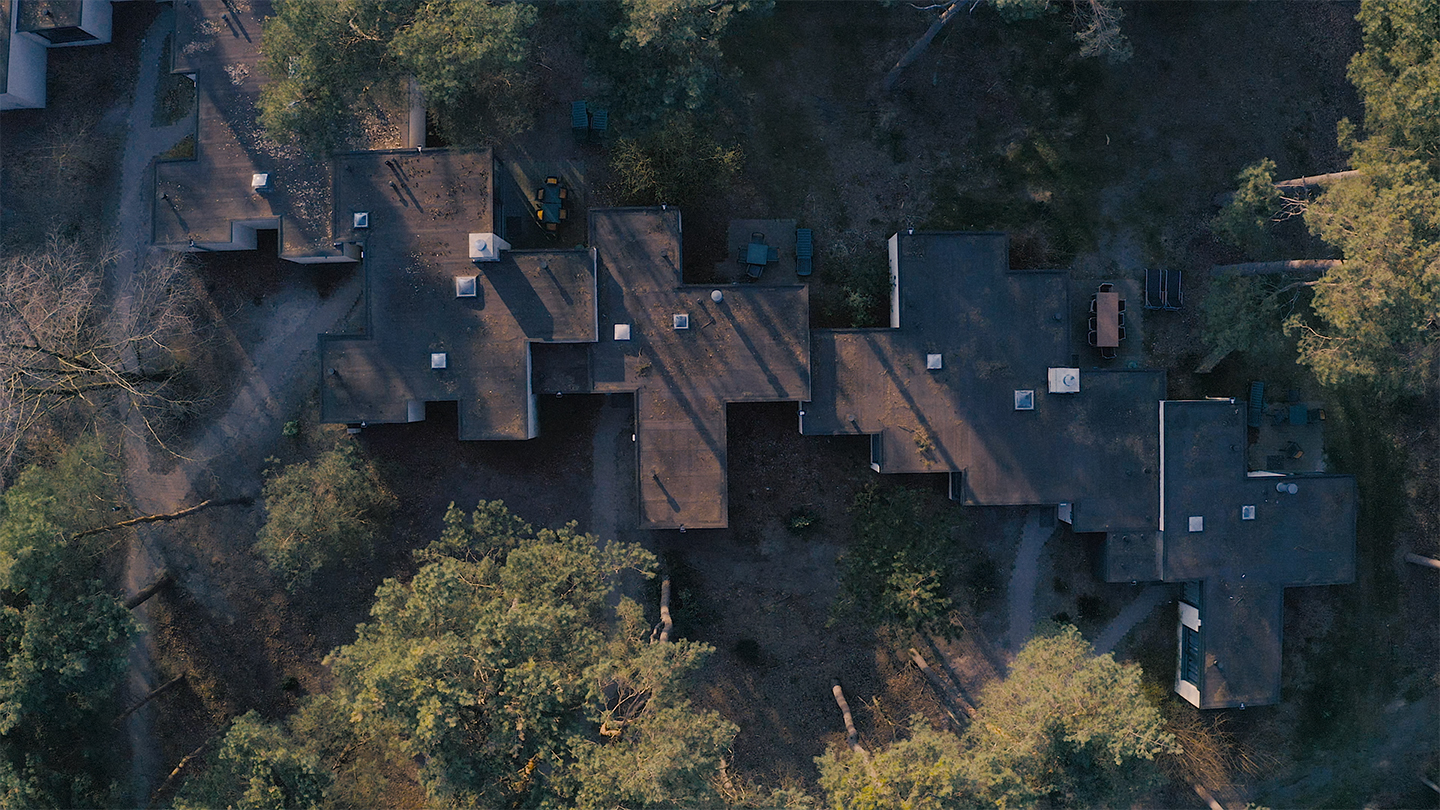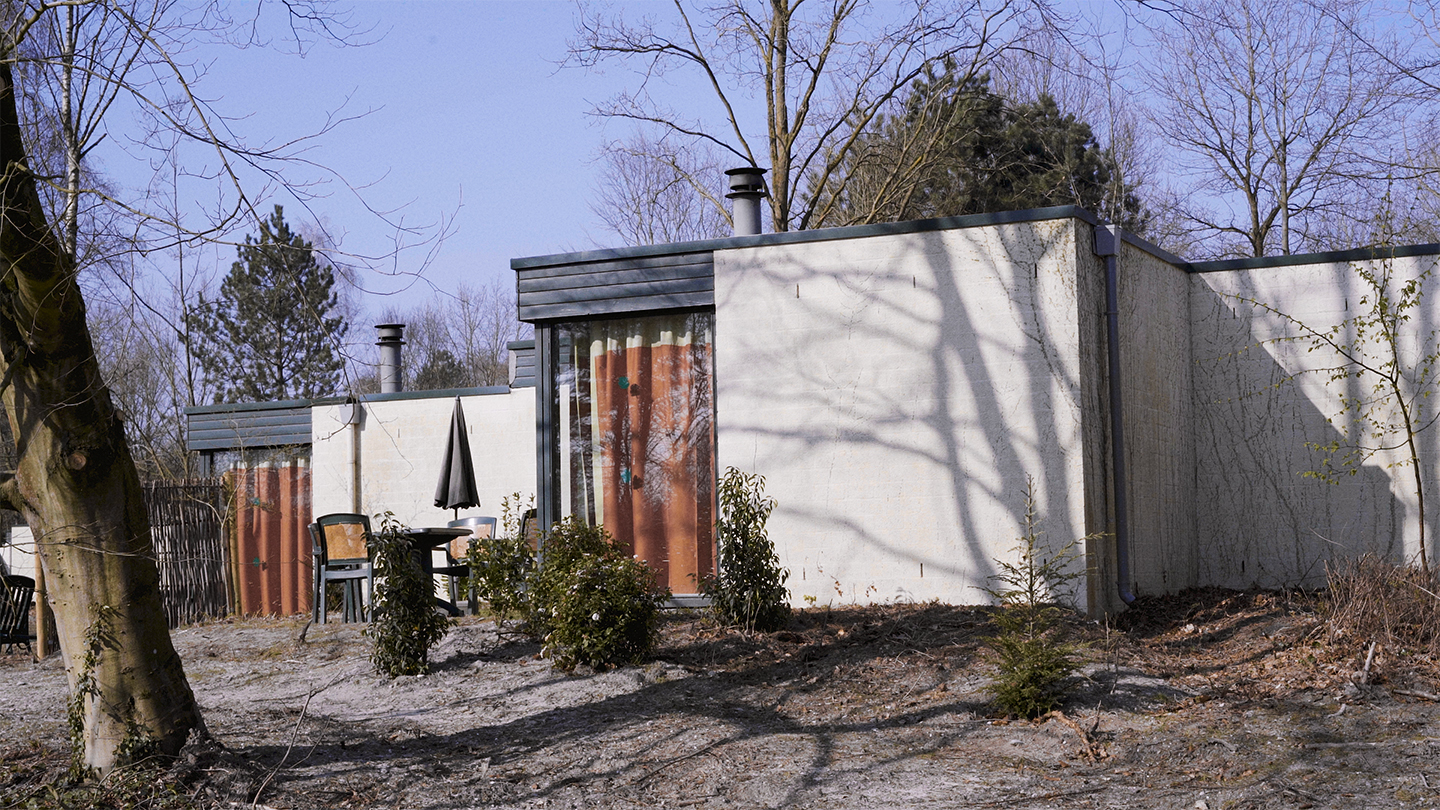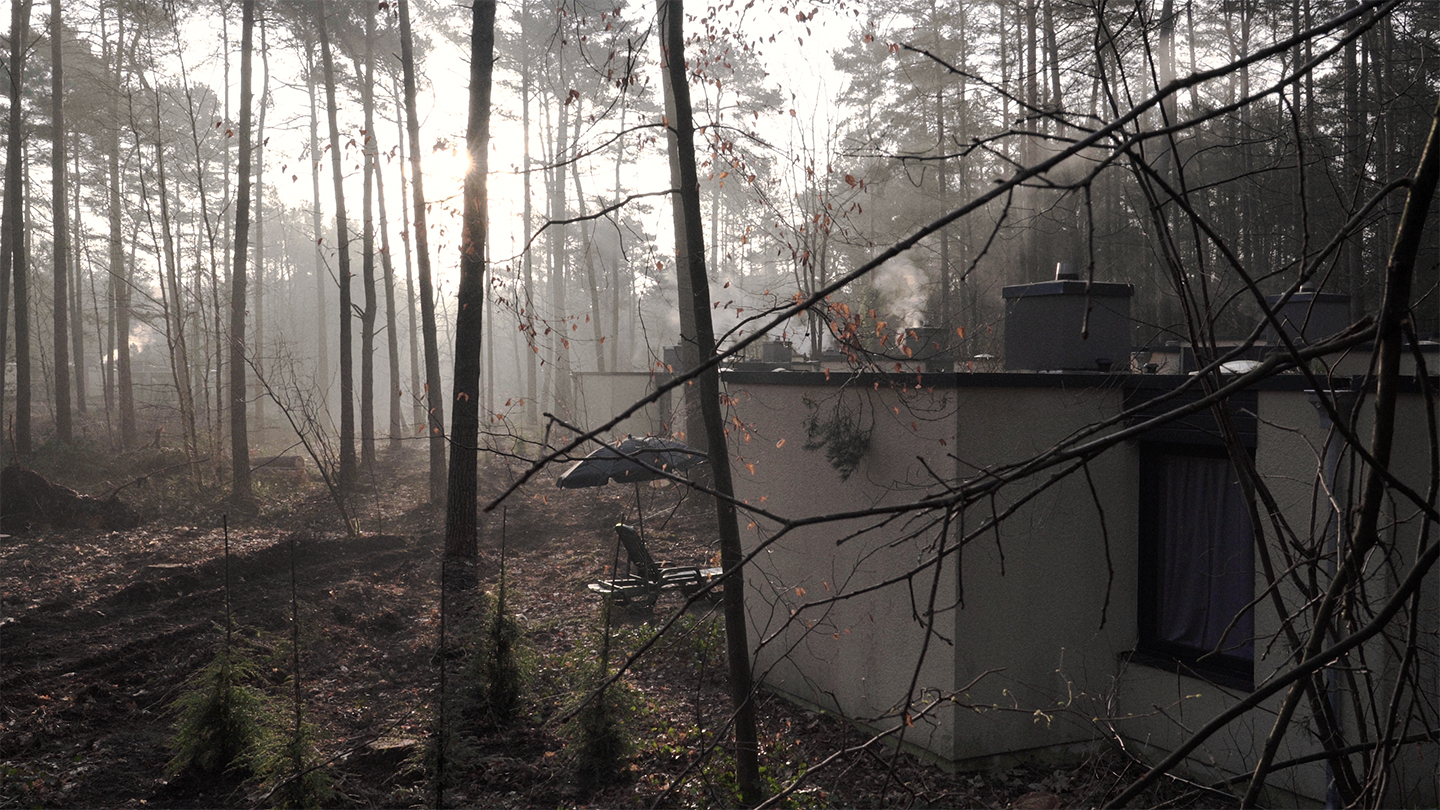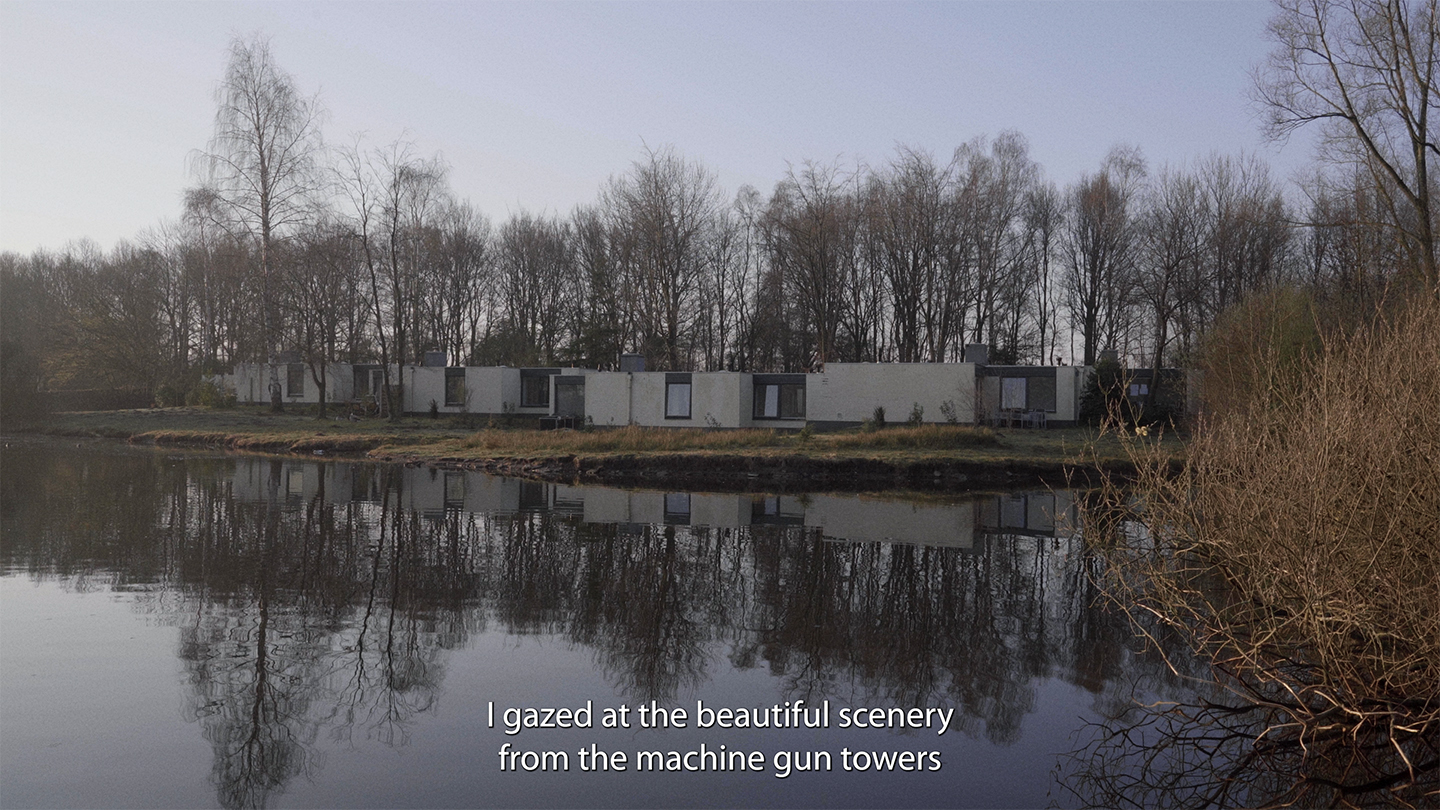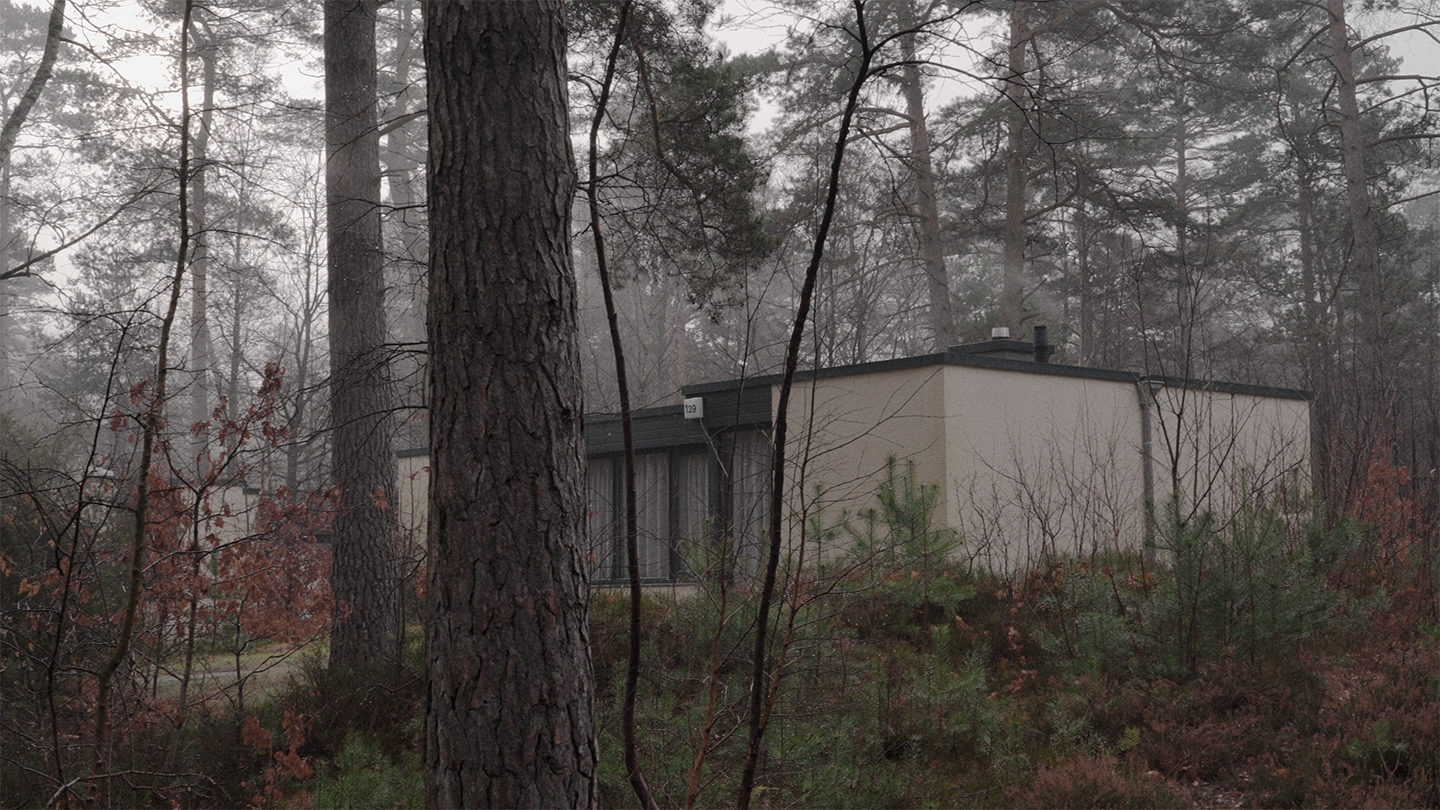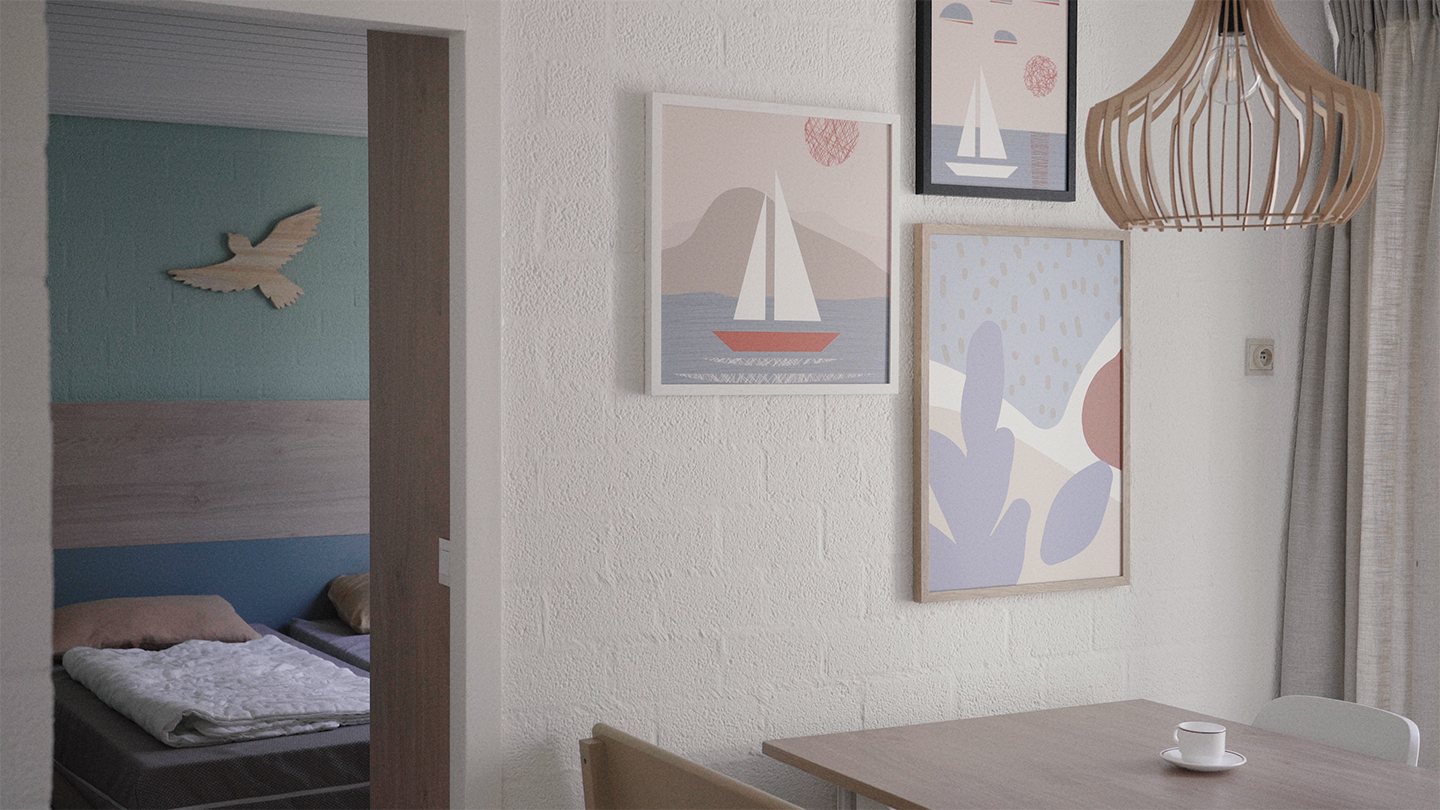


Into the Paradise Machine
1. Video Screening & Lecture Performance, Full HD Video, Stereo, 55:00 min, 2022
2. Video Screening & Lecture Performance, Full HD Video, Stereo, Live Score by Schneider TM, ca. 75 min, 2024
3. Video Installation, UHD Video, Stereo, 55:00 min, 2023
This work is part of the multimedia project The Paradise Machine. In its current iteration, The Paradise Machine consists of the video installation and lecture performance Into the Paradise Machine (2022/23), the found-footage video Today on Lumen 2000 (2024), the mixed media installation A State of Happiness (2024), and a scenographic exhibition display.
| – |
The Paradise Machine is the latest comprehensice project by Berlin-based artist Niklas Goldbach. Starting point for the project are the Center Parcs bungalow complexes built in the 1970s in the Netherlands for family holidays, a fusion of Dutch modernist ideals and Catholic moral conservatism. The Corona pandemic has given Center Parcs a new status as regional and supposedly safe holiday resorts, decidedly aiming towards traditional family structures. Since its founding in 1967, the franchise has offered families a “second home for a short holiday in the countryside” in more than 30 European holiday parks. The parks share a corporate identity and have the same basic structure: they consist of over 800 uniform single-family homes in wooded areas, grouped around a lake and a “Market Dome”, which also houses a subtropical adventure pool and restaurants. The interconnected groups of bungalows were built for the comfort of a new middle class – to this day, criticised as too commercial and an excess of consumer culture that disrupts and imitates the natural environment.
Conceived as a multimedia installation, this first chapter, titled Into The Paradise Machine, focusses on the vast bungalow complexes that have been filmed in several Center Parcs in Germany, Belgium and the Netherlands in 2022. Shot with a variety of filming techniques and at different times of day, the work examines solely the design of the holiday homes which all share a similar spatial organisation and identical style, as well as their integration into the different vegetation zones of the parks in three different countries.
The accompanying performance lecture in form of a live 'voice over' departs from impressions of the diary of the Dutch architect Jaap Bakema, who was with his architecture firm Van den Broek and Bakema responsible for the design of the bungalow complexes. Written during his time as a prisoner in a German deportation camp Royallieu-Compiegne in the north of France in 1943, the diary reveals his survial and coping strategies and reveals insights in his views on the philosphy of nature, architecture and society.
Text: Niklas Goldbach, Volksbühne Berlin, Text Booklet, 5/2022
The Paradise Machine ist das neueste umfassende Projekt des Berliner Foto- und Videokünstlers Niklas Goldbach. Ausgangspunkt für das Projekt sind die in den 1970er Jahren in den Niederlanden für Familienurlaube entstandenen Bungalow-Anlagen der Center Parcs, eine Verschmelzung von niederländisch-modernistischen Idealen und katholisch-moralischem Konservatismus. Die Corona-Pandemie hat den Center Parcs einen neuen Status als regionale und vermeintlich sichere Urlaubsorte beschert, die sich dabei dezidiert an traditionelle Familienformen richten.
Seit ihrer Gründung im Jahr 1967 bietet das Franchise in mehr als 30 europäischen Ferienparks Familien ein „zweites Zuhause für den Kurzurlaub im Grünen“. Die Parks sind in ihrer Grundstruktur alle gleich aufgebaut und teilen eine Corporate Identity: sie bestehen aus Ferienhaussiedlungen von über 800 uniformen Einfamilienhäusern in Waldgebieten, die sich um einen See und einen „Market Dome“ gruppieren, in dem sich auch ein subtropisches Erlebnisbad und Gastronomie befinden. Die zusammenhängenden Bungalowgruppen wurden für den Komfort einer neuen Mittelschicht gebaut – Kritiker kritisieren sie bis heute als zu kommerziell, als ein Exzess der Konsumkultur, der die natürliche Umwelt stört und imitiert.
Als Multimedia-Installation konzipiert, konzentriert sich dieses erste Kapitel, betitelt Into The Paradise Machine, ausschließlich auf Videoaufnahmen der Bungalowanlagen, die in verschiedenen Center Parcs in Deutschland, Belgien und den Niederlanden gedreht wurden. Mit verschiedenen Aufnahmetechniken und zu unterschiedlichen Tageszeiten gedreht, untersucht die Arbeit die Gestaltung der Ferienhäuser, die alle eine ähnliche räumliche Organisation und einen identischen Stil aufweisen, sowie ihre Einbettung in die unterschiedlichen Vegetationszonen der Parks in drei verschiedenen Ländern.
Die parallel stattfindende Lesung in Form eines Live Voice Overs stellt Impressionen aus dem Tagebuch des niederländischen Architekten Jaap Bakema vor, der mit seinem Büro Van den Broek und Bakema für den Entwurf der Bungalowkomplexe verantwortlich war. Das Tagebuch, das er 1943 als Gefangener im deutschen Deportationslager Royallieu-Compiegne in Nordfrankreich schrieb, offenbart seine Überlebens- und Bewältigungsstrategien und erlaubt Einblick in seine philosophischen Ansichten über Natur, Architektur und Gesellschaft.
Text: Niklas Goldbach, Volksbühne Berlin, Programmheft 5/2022
| – |
[…] By contrast, Center Parcs are popular and profitable tourist destinations to this day. The chain of holiday parks, with franchises in the Netherlands, Belgium, Germany, France and England, offers families a ‘second home for a short holiday in the countryside’. It was founded in the late 1960s by the Dutch entrepreneur Piet Derksen (1913–1996), who had been running a sporting goods shop in Rotterdam since 1953, which he developed into a nationwide retail chain operating under the name Sporthuis Centrum. In 1968, Derksen opened his first holiday camp in a wooded area near Reuver, a small town in Limburg, and named it Sporthuis Centrum De Lommerbergen. While guests initially slept in tents, these were soon replaced by aluminium lodges. Together with the Dutch architect Jacob (‘Jaap’) Bakema (1914–1981), Derksen eventually developed the concept of clustered bungalows set out in a staggered terrace arrangement and integrated into the surrounding landscape. The spacious villas all had a similar layout and identical style. Today, all Center Parcs feature an adventure pool as well as a shopping and restaurant area, with some boasting also a domed artificial subtropical landscape.
In Into the Paradise Machine (2022), Goldbach has edited footage of bungalow complexes in Center Parcs in various countries into an entire day on film, from sunrise to nightfall. The soundtrack combines a hypnotic soundtrack by Schneider TM with excerpts from Bakema’s diary, written in 1943 during his time as a prisoner in the German deportation camp Royallieu-Compiègne in northern France.
In it, Bakema describes the camp and his fellow inmates, who expect to be deported to Germany at any time. He muses on class differences between prisoners, describes the boredom and constant waiting (for food), the hunger – and how his thoughts begin to drift off when there is nothing to do and nothing to eat. But nature and the surroundings of the camp help him to cope with the situation. Bakema is a relatively privileged inmate. He works as a painter and draughtsman for a German sergeant who is a carpenter – and a Catholic, like himself. Bakema designs furniture and plans the expansion of the carpenter’s workshop.
In Goldbach’s video, the voice-over of the diary entries creates a hallucinatory effect that conflates the images of the bungalows with life in the camp in Compiègne. In today’s Center Parcs, holidaymakers find solace and tranquillity in the surrounding landscape – just like the imprisoned architect in 1943. As a viewer, one cannot help but wonder to what extent Bakema’s Center Parcs bungalow architecture of the 1970s and 1980s was inspired by his time in the camp […].
Inke Arns, excerpt from "The Paradise Machine - Of Towers and Foundation Pits in the Works of Niklas Goldbach"
Introductory text to the exhibition publication "The Paradise Machine", HMKV Dortmund, 16 March - 1 September 2024
[…] Eine im Gegensatz dazu noch heute gut funktionierende touristische Destination sind die Center Parcs. Dabei handelt es sich um Ferienparks in den Niederlanden, Belgien, Deutschland, Frankreich und England. Sie bieten Familien ein „zweites Zuhause für einen Kurzurlaub auf dem Land“. Gegründet wurden sie von dem niederländischen Unternehmer Piet Derksen (1913–1996). Seit 1953 betrieb dieser das „Sporthuis Centrum“-Geschäft in Rotterdam, welches sich zu einer landesweiten Handelskette entwickelte. 1968 eröffnete Derksen in einem Waldstück bei Reuver, einer Kleinstadt in Limburg, sein erstes Feriencamp: das Sporthuis Centrum De Lommerbergen. Logierten die Gäste zunächst in Zelten, wurden diese bald durch Aluminium-Ferienhäuser ersetzt. Zusammen mit dem niederländischen Architekten Jacob („Jaap“) Bakema (1914–1981) entwickelte Derksen schließlich das Konzept von versetzt in die Landschaft integrierten Ferienhäusern – weitläufigen Bungalowkomplexen, die alle eine ähnliche räumliche Organisation und einen identischen Stil aufweisen. Jeder Center Parc besitzt ein Erlebnisbad sowie eine Einkaufs- und Restaurantmeile. Manche verfügen außerdem über künstliche subtropische Landschaften unter einer Kuppel.
In Into the Paradise Machine (2022) montiert Niklas Goldbach Aufnahmen der weitläufigen Bungalowkomplexe von Center Parcs in verschiedenen Ländern zu einem ganzen filmischen Tag, vom Sonnenaufgang bis in die Nacht. Dazu hören wir nicht nur den hypnotischen Soundtrack von Schneider TM, sondern auch Auszüge aus Jaap Bakemas Tagebuch, das er 1943 während seiner Zeit als Gefangener in dem deutschen Deportationslager Royallieu-Compiègne in Nordfrankreich schrieb.
Bakema beschreibt das Lager und die mit ihm dort Inhaftierten, die jederzeit mit einem Abtransport nach Deutschland rechnen müssen. Er sinniert über die Klassenunterschiede unter den Gefangenen, beschreibt die Langeweile und das ständige Warten (auf Essen), den Hunger – und wie seine Gedanken zu kreisen beginnen, wenn es nichts zu tun und zu essen gibt. Die Natur und die Umgebung des Lagers helfen ihm jedoch, mit der Situation zurechtzukommen. Der Architekt Bakema ist ein relativ privilegierter Lagerinsasse. Er arbeitet als Maler und Zeichner insbesondere mit einem deutschen Unteroffizier zusammen, der Schreiner ist – und Katholik wie Bakema. Für diesen entwirft der niederländische Architekt Möbel und plant die Erweiterung von dessen Schreinerwerkstatt.
In Niklas Goldbachs Video verschwimmen die Aufnahmen der Center Parcs-Bungalows durch die eingesprochenen Tagebuchaufzeichnungen von 1943 auf halluzinatorische Weise mit dem Lager in Compiègne. In den heutigen Center Parcs finden Urlauber*innen Trost und Erholung in der Landschaft, in die die Bungalows eingebettet sind – wie der internierte Architekt 1943. Und man fragt sich als Zuschauer*in unwillkürlich, wie viel von Jaap Bakemas Center Parcs-Bungalow-Architektur der 1970er und 1980er Jahre von seiner Zeit im Lager inspiriert ist […].
Inke Arns, Auszug aus „Die Paradiesmaschine - Von Türmen und Baugruben in den Arbeiten von Niklas Goldbach",
Einleitungstext zur Ausstellungspublikation „The Paradise Machine", HMKV Dortmund, 16.3.- 1.9.2024
| – |
The Center Parcs franchise, which was founded in the Netherlands in the late 1960s, made it possible to holiday all year round in the rainy and moderately warm countries of northern Europe. Its model stands at the crossroads of various historical developments and moments between modernity and postmodernity – between, on the one hand, processes of ‘homogenisation and massification connected with the building of […] industrial capitalist economies’ and, on the other, ‘individualisation and de-massification connected with the […] reconstruction of […] capitalism towards […] information- and services-based economies’.
Center Parcs reflect the rationalist and functionalist methods and ideologies of New Building aimed at standardising the body, space and production, which shaped industrial and residential construction alike. Arising from the housing shortage of the 1920s, these principles were implemented in concrete on the ‘vacant spaces’ of bombed-out European cities in the wake of the Second World War. They stand for the biopolitics that put living and working, hygiene and healthcare, leisure and entertainment in the service of the preservation and regeneration of productive forces. Because only ‘healthy production and reproduction conditions’ create ‘the basis for the effective workforce required by industrial commodification’ – and vice versa. The economic and social structures, modes of functioning and infrastructures of mass tourism, at the heart of which lie holiday resorts such as Center Parcs, are part of these biopolitics and their moves between regeneration and self-optimisation […].
From 1980, further developments of the initial Center Parcs prototype centred on the glass-domed subtropical fun pool called Aqua Mundo and its attendant shopping and restaurant mall, the Market Dome, which have remained the company’s trademarks ever since. ‘It was the moment’, according to Tim O’Callaghan, ‘that Center Parcs morphed from “the villa in the forest” to “the machine in the garden”.’ This development can be seen as one of the many offshoots in the history of the industrial production and simulation of exotic worlds, beginning in 1851 with the Crystal Palace in London and the archetype of which is the greenhouse. At the provisional end of this strain, we find the failed 1990s project Biosphere 2, which attempted to create an ecosystem independent of the outside world, and the highly successful Tropical Island water park, which has been housed in a former airship hangar in Brandenburg since 2004 and – like the Crystal Palace and subsequent world expositions – aims to bring ‘foreign’ worlds to our own (European) doorstep in a kind of virtual ‘tourism-without-the-travel’.
Specifically, Center Parcs can be traced back to Piet Derksen, a businessman who was close to the extreme Catholic right. In 1953, he opened a sports shop in Rotterdam’s Ljinbaan, one of Europe’s first pedestrian zones, conceived by Van den Broek en Bakema. At Sporthuis Centrum, which was designed by the same architectural office, customers could not only buy camping gear but also book holidays. Ten years later, Derksen set up his first holiday destination under the same brand name near Reuver, which initially accommodated only tents and was reserved for his employees and customers. In 1968, the same location was chosen for the first holiday village in the woods, again designed by Van den Broek en Bakema, which became the basic model for all subsequent Center Parcs (as they would be called from 1986). Today’s parks comprise up to a thousand uniform bungalows, albeit varying in size, comfort and price range. Besides an Aqua Mundo and a Market Dome, they now also feature tree houses, houseboats and hotel rooms as well as a wide range of sports and entertainment options that can be booked individually like from a menu list.
[…] The endless water slides of Aqua Mundo, which in the video Into the Paradise Machine have been left out just like the people, find their ghostly counterpart in the shots of the disused Vietnamese water park Hồ Thủy Tiên, which appears in Goldbach’s latest video, Paradise Now. In the former, which combines exterior and interior shots of the bungalows of three different Center Parcs in such a way that they become undistinguishable, Goldbach seems to unearth the facilities’ original modernist form beyond their current postmodern transformation by the spectacle – and one hardly understand how, even in the aerial shots, he managed to keep the dominant glass roofs and domes of the entertainment facilities out of the picture. It works like a kind of reverse palimpsest. In this video, time seems to have been turned back, and only the smoke rising here and there from the chimneys indicates that someone is there.. At times, it feels like nature is in the process of reappropriating the deserted territories […].
Iris Dressler, Excerpts from "Soft Cops",
Essay of the exhibition publication "The Paradise Machine", HMKV Dortmund, 16 March - 1 September 2024
[…] Die Ende der 1960er Jahre in den Niederlanden entstehenden Center Parcs, die den ganzjährigen Urlaub auch in den regenreichen und nur mäßig warmen Gebieten Nordeuropas populär machten, lassen sich als Kreuzungspunkt verschiedenster historischer Entwicklungen und Momente zwischen Moderne und Postmoderne lesen: zwischen Prozessen einerseits der „Homogenisierung und Massifizierung, die mit dem Aufbau von […] kapitalistischen Industrieökonomien“ einhergehen, und andererseits der „Individualisierung und Demassifizierung, die mit dem Umbau des Kapitalismus […] hin zu […] informations- und dienstleistungsbasierten Ökonomien“ verbunden sind.
Die Center Parcs spiegeln die rationalistischen und funktionalistischen, auf die Normierung von Körper, Raum und Produktion zielenden Methoden und Ideologien des Neuen Bauens wider, die den Lager- und Wohnungsbau gleichermaßen geprägt haben. Dem Problem der Wohnungsnot der 1920er Jahre entsprungen, wurden sie in Europa vor allem nach dem Zweiten Weltkrieg auf den „Leerflächen“ zerbombter Städte in Beton gegossen. Sie stehen für jene Biopolitiken, die Wohnen und Arbeiten, Hygiene und Gesundheitswesen, Freizeit und Unterhaltung in den Dienst der Stabilisierung und Regeneration von Produktivkräften stellen. Denn „gesunde Produktions- und Reproduktionsverhältnisse“ schaffen erst „die Grundlage effektiver Produktivkräfte industrieller Fertigungen“ – und umgekehrt. Die ökonomischen und sozialen Strukturen, Funktionsweisen und Infrastrukturen des Massentourismus, zu dessen Kern Ferienanlagen wie die Center Parcs zählen, sind Teil dieser Biopolitiken und ihrer Bewegungen zwischen Regeneration und Selbstoptimierung. […]
Die Weiterentwicklung des schlichten Prototyps der Center Parcs wird ab 1980 vor allem durch das von einer Glaskuppel überdachte subtropische Spaßbad, das Aqua Mundo, und eine damit verbundene Shopping- und Restaurantmall, den Market Dome, geprägt, die seither das Markenzeichen des Unternehmens bilden. Es war der Moment, so Tim O’Callaghan, „als sich die Center Parcs vom ‚Dorf im Wald‘ zur ‚Maschine im Garten‘“ wandelten. Diese Entwicklung kann als einer der vielen Ausläufer in der Geschichte der industriellen Produktion und Simulation exotischer Welten betrachtet werden, deren Archetyp das Gewächshaus ist und die ihren Anfang 1851 mit dem Crystal Palace in London nahm. Am vorläufigen Ende dieses Ausläufers, so scheint es, stehen gleichermaßen das gescheiterte Projekt Biosphäre 2, mit dem in den 1990er Jahren versucht worden war, ein von der Außenwelt unabhängiges Ökosystem zu schaffen, und der äußerst erfolgreiche Wasserpark Tropical Island, der seit 2004 in Brandenburg in einem ehemaligen Luftschiff-Hangar untergebracht ist und – wie einst der Crystal Palace und die darauffolgenden Weltausstellungen – in einer Art virtuellem „Tourismus ohne Reisen“ die „fremden“ Welten vor die eigene europäische Haustür bringt.
Konkret gehen die Center Parcs auf den der extremen katholischen Rechten nahestehenden Geschäftsmann Piet Derksen zurück. 1953 eröffnete er in einer der ersten Fußgängerzonen Europas, der von Van den Broek en Bakema entworfenen Ljinbaan in Rotterdam, das Sporthuis Centrum, ein Sportgeschäft, das von selbigem Büro gestaltet wurde. Hier konnte man nicht nur Campingausrüstungen erwerben, sondern auch Urlaubsreisen buchen. Zehn Jahre später errichtete Derksen in der Nähe von Reuver unter demselben Markennamen seine erste eigene Feriendestination, die anfangs nur für Zelte und zum Wohl seiner Mitarbeiter*innen und Kund*innen gedacht war. 1968 entsteht an diesem Ort schließlich das erste von Van den Broek en Bakema entworfene Feriendorf im Wald, das bis heute die Grundform der Center Parcs, wie sie erst ab 1986 heißen sollen, bildet. Mittlerweile umfassen die Anlagen bis zu tausend uniforme Bungalows, die allerdings in Größe, Komfort und Preisklasse variieren. Neben dem Aqua Mundo und dem Market Dome sind überdies Baumhäuser, Hausboote und Hotelzimmer sowie ein breites Sport- und Entertainmentangebot, das man individuell, wie auf einer Speisekarte, buchen kann, hinzugekommen […]
Die endlosen Wasserrutschen des Aqua Mundo, die in dem Video Into the Paradise Machine ebenso ausgeblendet werden wie die Menschen, finden ihre geisterhafte Entsprechung in den Aufnahmen des stillgelegten vietnamesischen Wasserparks Hồ Thủy Tiên, die in dem jüngsten Video Goldbachs, Paradise Now, zu sehen sind. In Ersterem, das die Außen- und Innenaufnahmen der Bungalows dreier verschiedener Center Parcs kaum voneinander unterscheidbar in eins setzt, scheint Goldbach die modernistische Urform der Anlagen jenseits ihrer aktuellen postmodernen Überformungen durch das Spektakel aufzusuchen – und man begreift kaum, wie er es geschafft hat, dass selbst in den Luftaufnahmen die dominanten Glasdächer und -kuppeln der Entertainment Facilities nicht ins Bild geraten. Es ist wie eine Art umgekehrtes Palimpsest. Die Zeit scheint in diesem Video zurückgedreht und nur der Rauch, der hie und da aus einem Kamin aufsteigt, verweist darauf, dass da jemand ist. Mitunter entsteht der Eindruck, als sei die Natur im Begriff, sich die menschenleeren Territorien wieder anzueignen […].
Iris Dressler, Auszüge aus „Soft Cops", Essay der Ausstellungspublikation „The Paradise Machine", HMKV Dortmund, 16.3.- 1.9.2024
| – |
The first words uttered in Joseph Conrad’s Heart of Darkness (1899) were those of the protagonist speaking about the place where his journey originated: “‘And this also,’ said Marlow suddenly, °‘has been one of the dark places of the earth.’” One might venture so far as to say that Niklas Goldbach has not taken a single photograph of a human being in his works. Which, considering his background in sociology and a photography practice spanning nearly two decades, testifies to a persistence and a sense of observation focused not on our interactions, but on what comes before and structures our existence: space, architecture, and social engineering.
For The Paradise Machine, Goldbach’s most comprehensive exhibition to date, curated by Inke Arns, the artist transformed Dortmund’s Hartware MedienKunstVerein into a maze. A labyrinth of cubicles, perhaps a makeshift hotel or an Airbnb rental outfitted with the most basic beds, common spaces carpeted with artificial turf and dotted with palm trees (which resemble real plants and perhaps they are), with an odd disco ball casting specks of light, and sections of construction fence set up here and there, held by concrete slabs. It is not immediately certain if those are knockoffs of tourist bungalows set up to welcome scores of revelers looking for entertainment in remote locations, or fragments of an ever-growing, and seemingly never-ending and seemingly never-ending, construction site that has engulfed many cities in Germany. […] Goldbach’s exhibition design and scenography is inspired by the Center Parcs, a Dutch enterprise founded in the 1970s with the idea of offering a year-round possibility to relax in one of its “holiday villages.” While Permanent Daylight evokes this promise of universal access to happiness across the globe, the 2022 video Into the Paradise Machine combines footage from the original villages, taken in 2021, with a voice-over of a diary by the Center Parcs’ architect Jaap Bakema (1914–1981) in a different kind of a highly organized compound: the German deportation camp Royallieu-Compiègne in northern France. In Goldbach’s film, the austere architecture of the Center Parcs clashes with descriptions of life in the camp: “The population of this prison camp consists mostly of Frenchmen of all kinds, sick people, cripples and people with any form of disability picked up from the streets and cafes, also black marketeers and, some say, communists. […].
Goldbach examines how human desire can propel our actions, while rarely adopting a direct moral stance. His readings of modernity, identity, the colonial and decolonial in their complexity, the exotic and self-exoticization, as well as the unconditional implication of both the viewers and himself in the narratives we are invited to experience, are never one-sided: at the verge of permanent daylight there is invariably a brooding darkness.
Krzysztof Kosciuczuk, excerpt from "Niklas Goldbach: The Paradise Machine", Exhibition Review, Camera Austria No.166, p 76
| – |
Credits:
Camera, Editing, Postproduction: Niklas Goldbach
Sound Design & Music Re-edit: Niklas Goldbach
Sound Mix: Schneider TM
Main Musical Score: "Invisible Hand" by Schneider TM © Mirrorworld Music 2018
Diary transcript: Het Nieuwe Instituut Rotterdam
Translation: Niklas Goldbach, Rabea Riedlhammer, Esper Postma
With Support of Center Parcs Europe N.V. & Het Nieuwe Instituut Rotterdam
Sponsored by the Federal Government Commissioner for Culture and the Media NEUSTART KULTUR

EXCERPT
Please contact the studio for the full documentation.
EXHIBITION VIEWS

Exhibition views:
Into the Paradise Machine, Video installation, UHD Video, 55 min., Stereo, 2022/23
"Niklas Goldbach: The Paradise Machine"
HMKV Hartware MedienKunstVerein Dortmund, 16.3.- 11.8.2024
Curated by Inke Arns
Photos 2-5: Roland Baege
EVENTS
INTO THE PARADISE MACHINE
Video Screening & Lecture Performance, Stereo, 55 min, 2022/23
Saalbau Witten, 09.08.2024
Photos: Daniel Sadrowski
INTO THE PARADISE MACHINE
Video Screening & Lecture Performance, Stereo, 55 min, 2022/23
10. f/stop Festival for Photography Leipzig: "Flucht in die Öffentlichkeit", HGB Gallery, Leipzig, 4.6.2024
Curated by Magdalena Stöger and Leon Hösl
Photos: Walther LeKon
INTO THE PARADISE MACHINE
Video Screening & Lecture Performance with Live Score by Schneider TM, ca. 75 minutes, 2024
HMKV im Dortmunder U, Cinema, 23.05.2024
Curated by Inke Arns
Photos
: Ermine Ercihan
INTO THE PARADISE MACHINE
Video Screening & Lecture Performance, Stereo, 55 min, 2022/23
06.10.2023, AFFR Architecture and Film Festival Rotterdam
https://www.affr.nl/specials/into-the-paradise-machine-live-performance-met-niklas-goldbach/
Photos: Sander van Wettum
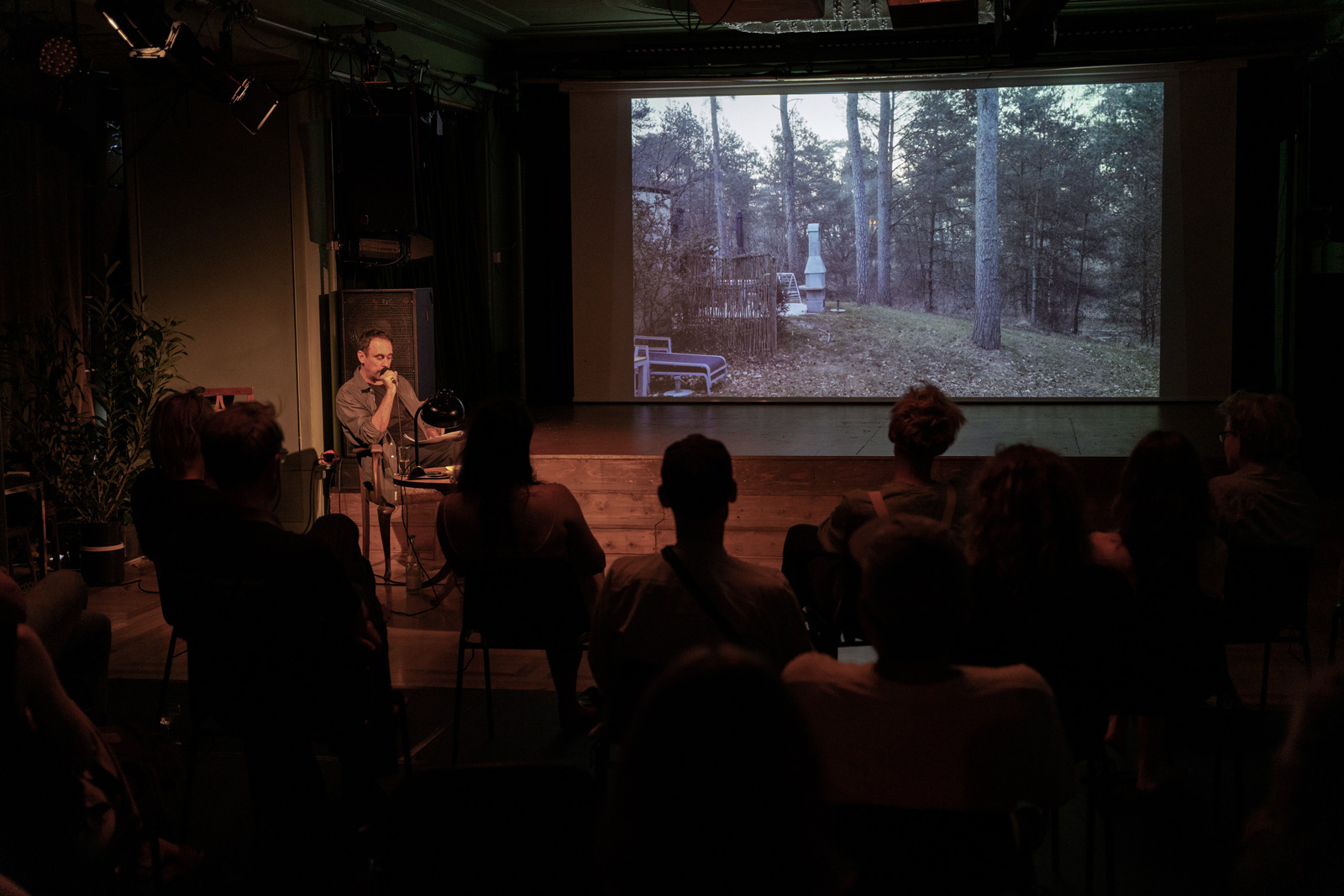
INTO THE PARADISE MACHINE
Video Screening & Lecture Performance, Stereo, 55 min, 2022
23.6.2022, Grüner Salon, Volksbühne Berlin
https://www.volksbuehne.berlin/#/de/veranstaltungen/into-the-paradise-machine
Photos: Christian Weller
INTO THE PARADISE MACHINE
Video Screening & Lecture Performance, Stereo, 55 min, 2022
28.5.2022, Die Möglichkeit einer Insel, Berlin
https://www.moeglichkeit-einer-insel.de/into-the-paradise-machine-performance-lecture-und-video-screening
Documentation: Jules Denner
VIDEO STILLS
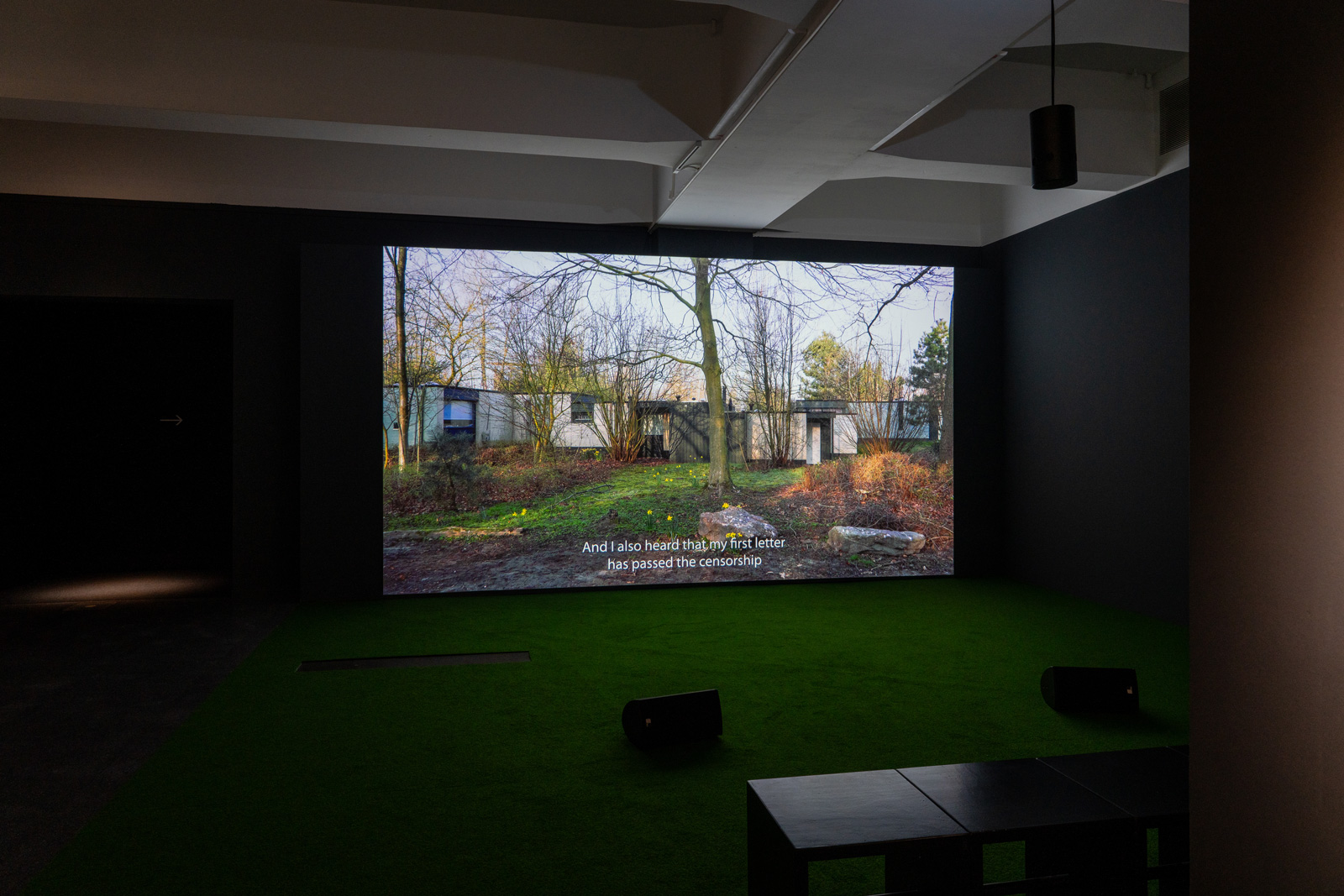



HMKV_30.jpg)
HMKV_23.jpg)







.jpg)
.jpg)
